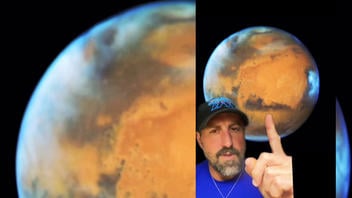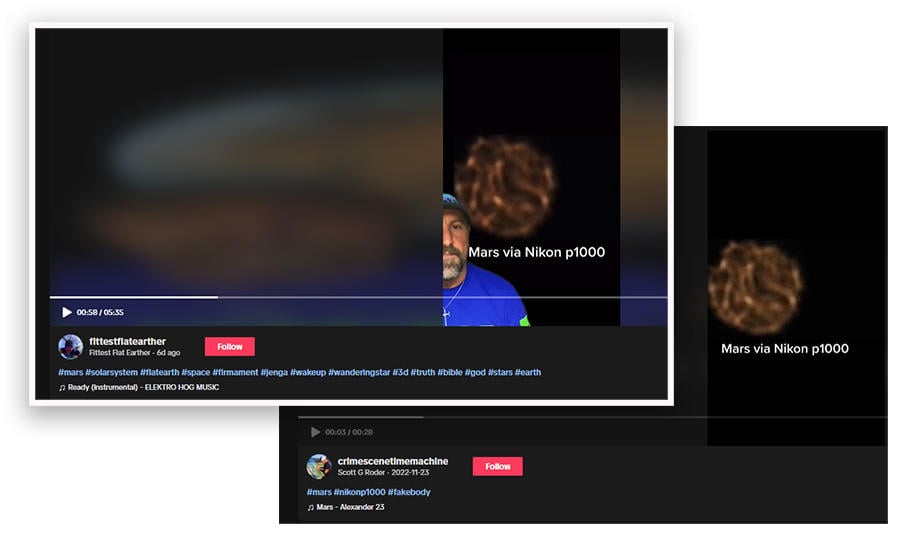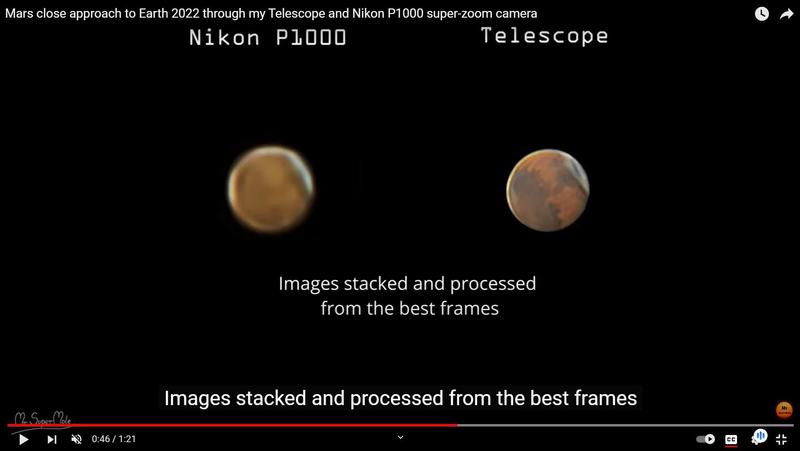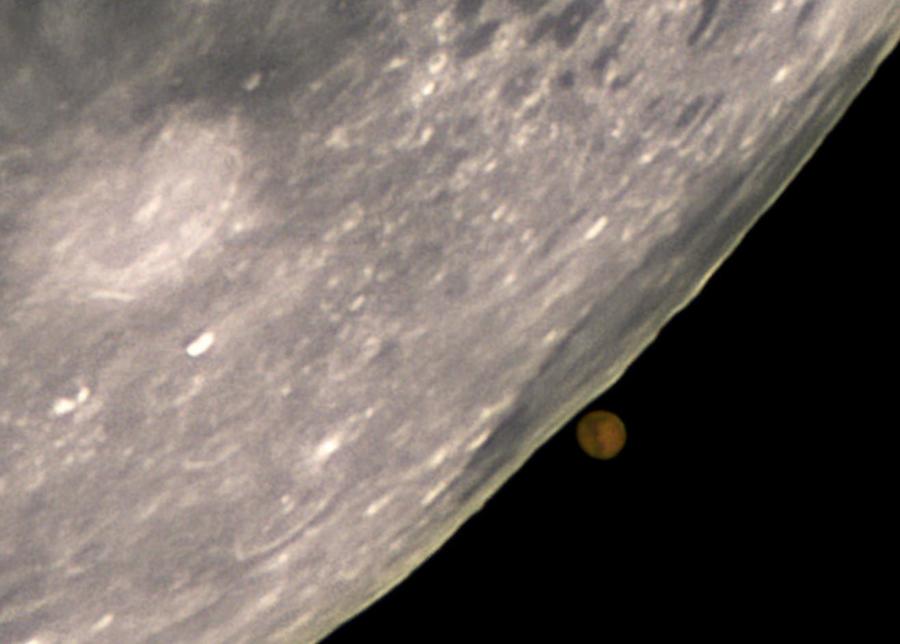
Does a video of Mars filmed with a Nikon p1000 camera prove that Hubble Space Telescope images of Mars are fake, and that Mars is not really a planet but a shining star that looks like "light shimmering in water"? No, that's not true: Images of Mars can vary considerably depending on the equipment, settings and atmospheric conditions. The resulting variations in amateur photography do not negate the body of scientific knowledge about Mars or the images of the terrestrial planet seen from world-class observatories, the Hubble Space Telescope, the orbiters and rovers from NASA's Mars Exploration Program, or even more skilled and better-equipped amateur astrophotographers.
The claim appeared in a video (archived here) published by @fittestflatearther on January 13, 2024, under the title "Mars Ain't No 'Planet.'" It was captioned with these hashtags:
#mars #solarsystem #flatearth #space #firmament #jenga #wakeup #wanderingstar #3d #truth #bible #god #stars #earth
This is what the post looked like on TikTok at the time of writing:
(Source: TikTok screenshot taken on Fri Jan 19 16:45:49 2024 UTC)
The 5:35-minute TikTok video begins with the narrator introducing an image of Mars taken by the Hubble Space Telescope on May 12, 2016. At that time, Mars was 50 million miles from Earth. The distance between Earth and Mars varies greatly and averages 140 million miles. A clip of a NASA Goddard video (see full video here) shows an animation of what it means for Earth and Mars to approach opposition, "when both planets are on the same side of the sun."
The narrator on TikTok sets up his question this way:
This is what NASA, this is what the education schoolbooks in the public indoctrination systems, even into college, is telling you that Mars looks like ... But why don't we look and see what Mars looks like from amateurs?
The @fittestflatearther video then shows two short video clips of Mars appearing to shimmer, as if seen sparkling through water. The clip beginning at 0:55 seconds is captioned "Mars via Nikon p1000." Lead Stories searched TikTok for the text in the caption "Mars via Nikon p1000," which led to a video posted on November 23, 2022, by @crimescenetimemachine (pictured below). The caption of the second shimmering clip at 1:06 minutes is obscured. Lead Stories was unable to make a positive match, although it resembles a March 3, 2021, video (at 27 seconds) by @goldenladle captioned, "MARS recorded with a Nikon p900."
The @fittestflatearther implies that NASA images of Mars cannot be trusted but that images from "thousands and thousands of amateurs that capture Mars with their own Nikon Cameras and with their own telescopes ..." show what Mars actually looks like.

(Source: Lead Stories composite image with TikTok screenshots taken on Fri Jan 19 20:37:24 2024 UTC)
Mercury, Venus, Earth and Mars are the four terrestrial planets. Planets do not shine like stars, but reflect the light of the sun. A NASA fact sheet on Mars describes the planet's structure as similar to Earth and the other terrestrial planets -- it has a dense core, a rocky mantle and a solid crust.
Lead Stories emailed Mary McIntyre, an astrophotography lecturer who runs the website Mary McIntyre Astronomy, for an explanation of the shimmering appearance of these video clips. McIntyre responded by email on January 19, 2024. She wrote:
Cameras that use automatic focusing rely on their sensors detecting the object and trying to figure out how far away the object is. Autofocus in low light is challenging but when pointing at the stars or planets they are much too far away for the camera to accurately detect them and therefore the camera will rarely achieve the correct focus automatically. The result is an out of focus blob. If manual focus is used on your camera, Mars will simply look like a pin-point red-coloured star. Even with good focus, cameras with digital zoom will not give you enough magnification to see any kind of surface features.
In the video the out of focus blob is shimmering and was described as looking like 'light shimmering in water'. That's because it essentially IS shimmering through water; the water in Earth's atmosphere. When we observe any planet or the Moon through a telescope, the whole surface appears to be covered in a shimmering layer that causes the object to come in and out of focus. This is called 'atmospheric seeing' and it occurs because we are observing space through a thick layer of moisture and pollutants such as dust and pollen. The effect is also made worse by heat rising from buildings. This is why most professional observatories are located at the top of mountains above some of this layer and it's why our space telescopes give us even better results because they're completely free of atmospheric seeing. In the video, the out of focus light from Mars is being distorted by atmospheric turbulence - almost every star and planet will look like this if you view it out of focus.
A November 27, 2022, video posted on YouTube by @Mr Supermole, an astrophotography hobbyist, is titled, "Mars close approach to Earth 2022 through my Telescope and Nikon P1000 super-zoom camera." He shows side-by-side images of Mars filmed at the same time with two of his setups, a Nikon Coolpix P1000 at the maximum zoom (125x optical zoom + 3.6x digital zoom) with manual focus, alongside a GSO N-203/800 f/4 + Barlow lens 3x + 10-millimeter eyepiece telescope with a Sony a6400 camera. At 36 seconds into the video, the "atmospheric seeing" can be observed distorting both images, and at 43 seconds the images have been stacked and processed from the best frames.
(Source: YouTube screenshot taken on Fri Jan 19 21:29:28 2024 UTC)
McIntyre explained stacking like this:
Tens of thousands of amateur astronomers successfully photograph Mars with their backyard telescopes. The telescope is focused correctly then a short video clip is captured. If you watch that raw video you will clearly see the atmospheric turbulence but computer software can pull out the frames that have good focus but ignore the blurred ones, then digitally stack the good ones together to produce a more detailed, sharp image that will show some of the surface features of Mars.
The NASA website has a page about the advantages of having the Hubble telescope in space, about 326 miles above the Earth's surface. Topping the list is that its view is distortion- free:
When you look up at the stars in the sky, they seem to twinkle. That's because shifting pockets of air in Earth's atmosphere distort your view, even on the clearest nights. When astronomers try to take a picture of a cosmic object from the ground, that picture ends up blurry. Hubble's position above the atmosphere lets it observe steady, unwavering light from cosmic objects and thus achieve higher resolution.
World-class observatories on Earth can produce high-quality images of objects beyond Earth's atmosphere with a technology called "adaptive optics." Laser beams, rapid computer processing and a precisely flexible mirror can correct an image that was distorted as it passed through the atmosphere.
In a lecture at the 2019 Practical Astronomy Show in Kettering, Northamptonshire, England, the award-winning amateur astronomer and astrophotographer Damian Peach explained some of the lengths to which he will go for high-resolution photography of the planets, including travelling with telescopes to remote places where degradation of the image will be minimal. A collection of high-quality images of Mars on his website demonstrates what is currently possible for a regular person to achieve with the right equipment under all the right conditions.
The image below, captured by McIntyre in December 2022, shows Mars emerging from behind Earth's moon. She used a 71-millimeter refractor, 3 x magnifying Barlow lens and ASI120MC camera.
(Source: Permission by Mary McIntyre, December 2022)
Additional Lead Stories fact checks of claims about outer space can be read here.
















